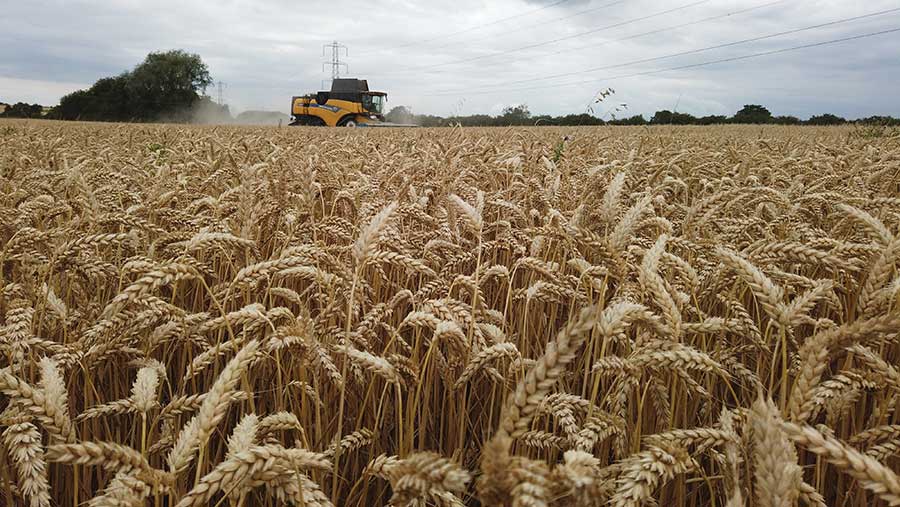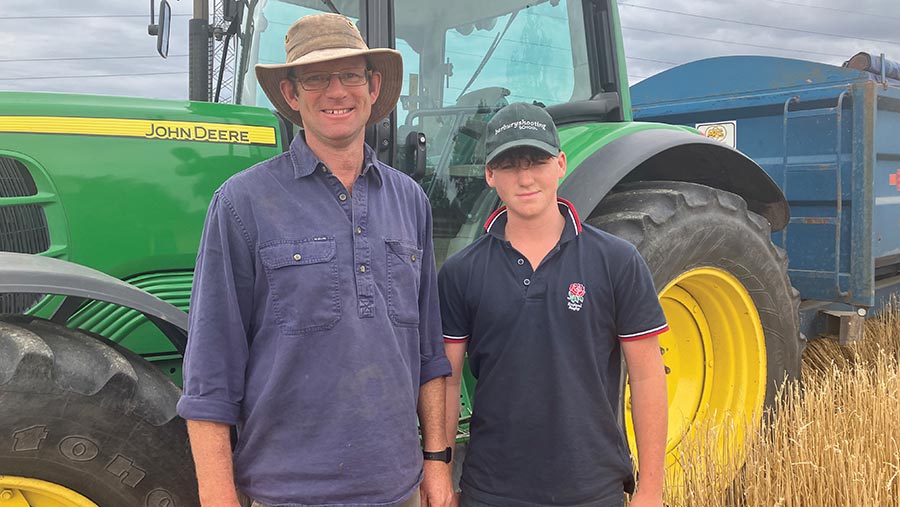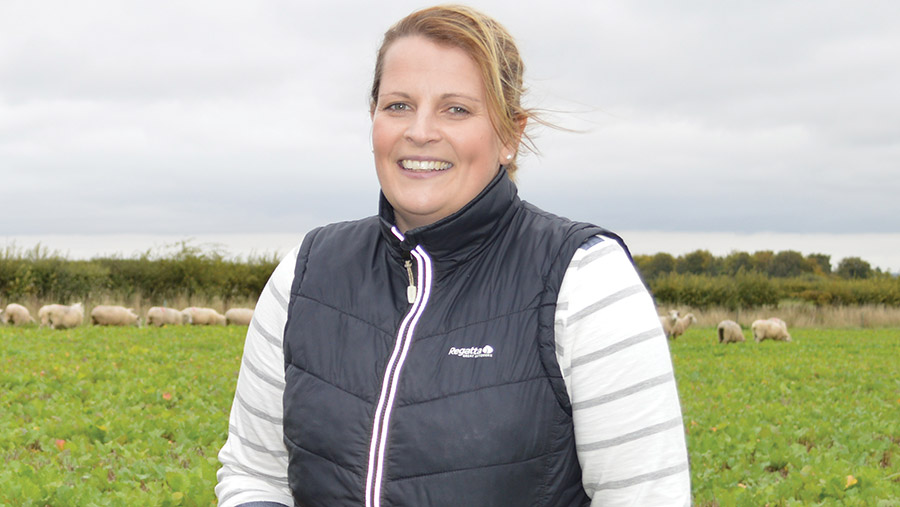How two farmers are cutting back on fungicides this spring
 © MAG/Emma Gillbard
© MAG/Emma Gillbard Two arable farmers are planning to dramatically cut back their fungicide spend this spring, helping to overcome rising chemical costs.
Wiltshire grower George Hosier aims to spend the absolute minimum, having spent the last 10 years moving to virtually fungicide-free crops.
And this spring, Jo Franklin is trialling the use of strategic sheep grazing to manage disease in forward wheat crops, thereby reducing chemical use on her Hertfordshire farm.
Farmers Weekly takes a closer look at how the two farmers are achieving their goal.
See also: Farmer grazes 2,500 sheep on cereal crops for disease control
Focus on soil
George Hosier’s journey to fungicide-free crops began 10 years ago when he “fell down the soil health rabbit hole” and started no-tilling, cover cropping and cutting back on nitrogen fertiliser.
He aims to keep fungicide spend to an absolute minimum or better yet, eliminate it completely across the farm’s 420ha of cropping.
“It is a no-brainer when it comes to improving soil health. If we want to promote soil biology and increase the fungal to bacterial ratio of soils, why are we spraying fungicides which prevents us achieving this?” he says.
George successfully grew 100% of his winter wheat area without a single fungicide two harvests ago with yields of 8-8.5t/ha.
Instead, regular crop walking and tissue analysis is used to target crop nutrition and promote healthy plants which can withstand disease attack.
Advice for farmers
For farmers contemplating cutting back on fungicide spend, George firstly recommends a focus on improving soils and then reducing nitrogen rates.
“The main challenge is cutting back on inputs in a way which maintains yields – otherwise cashflow can take a serious hit. Don’t just cut back for the sake of it,” he says.
Integration of the arable rotation
Integration of the farm’s 250 head of cattle within the arable rotation has provided soils with a real health boost.
Cattle graze over winter cover crops which make up 50% of the farm area ahead of spring drilling as well as grazing rotational herbal leys.
This enabled George to slash N use by over half compared to a decade ago.
Rates which once stood as high as 240kg N/ha for milling wheat, with yields of 9-9.5t/ha with a three-spray fungicide programme are now a remarkable 100-120kg N/ha with little to no fungicide spend. Yields now average 8-8.5t/ha.
“Because we are no longer pushing crops hard with fertiliser we weaned crops off of fungicides and now focus on crop nutrition.
“Production costs are a fraction of what they were,” says George.
“What’s more, the reduced input system shelters the business from cost fluctuations and suits marginal areas of the farm such as chalky flint soils which always struggled to hit double-digit yields.
“It also helps our soils become more resilient to weather extremes,” he adds.

Farmer George Hosier and son Fred © MAG/Emma Gillbard
Crop monitoring
Last season, 70% of Geroge’s 100ha wheat area was grown without a fungicide, excluding a proportion of Extase which he felt needed a gentle push at the T2 timing to keep it going.
“Most fungicides are preventative not curative, which makes monitoring crops essential.
“It can be a risky system if you start to see disease in crops, as in most cases this is too late to control,” he continues.
Assessing crop nutrition is, therefore, particularly important for growers looking to cut back on fungicides, as healthy crops with optimum nutrition levels have the ability to withstand disease attack, which in turn will help maintain yields.
“Silicon is good to include in micro nutrition spray mixes as it naturally strengthens crops from attack – be it fungal diseases or insects,” he says.
Regular crop monitoring, disease pressure alerts and weather forecasts are also used to inform crop management decisions.
“We’ve been faced with a challenging growing season so far and if this wet weather continues we may need to use a fungicide if disease pressure is high.
“I’ve just sent off my first tissue test for the season to build a picture of what crop nutrition levels are, but my overall aim is to keep fungicide use to an absolute minimum.”
Fungicide-free premium
This year, George is growing 116ha of wheat – predominantly Extase and a small area of wheat blends for the Wildfarmed market – which is allowing him to cash in on a premium price for wheat grown without fungicides.
Most of his wheats have received a small dose of 15kg N/ha. He usually applies four to five splits of N at 30kg/ha, but with such unpredictable weather a half rate was used.
George concludes: “By changing our system and using reduced inputs we’ve been able to start farming again and look at crops differently each season – rather than just following a precise plan.”
Sheep grazing helps farmer cut cereal fungicide spend

Jo Franklin © David Jones
Strategic sheep grazing in winter wheat is helping mixed farmer Jo Franklin manage crop disease in forward crops, and cut fungicide spend.
Grazing sheep from the beginning of February to the start of March across 50ha of winter wheat cut the need for a T0 fungicide, plant growth regulator and additional nutrition applications, with significant input savings.
In total, 350 sheep successfully grazed a 50ha area, removing wheat leaves infected with yellow rust and septoria, before producing fresh new leaves with no latent disease. This also stimulated tillering, promoted additional rooting, and cycled nutrients via sheep manure.
See also: Farmer grazes 2,500 sheep on cereal crops for disease control
Now there is lower overall disease pressure, Jo also hopes to cash-in on further cutbacks at the T1 timing, but notes close crop monitoring will be required.
With 2,000 ewes and a further 300 milking ewes at the Hertfordshire farm, there is no shortage of hungry sheep looking for a source of forage.
“Grazing cereal crops is something I have wanted to do but because it is such a labour-intensive task putting up electric fences and keeping a close eye on soil conditions, it had to be worthwhile,” she says.
“Since moving to a Muzuri strip-till system three years ago and focusing on building organic matter levels, integrating sheep into the rotation, cover cropping crops and investing in drainage, the benefits are really paying off with most crops looking well and coming out of winter forward.”
But with signs of yellow rust and septoria lurking in crops and soil conditions dry enough to withstand sheep grazing crops, Jo decided to set up a sheep grazing trial for the first time this season, with promising results to show for it.
A total of 350 sheep grazed a 50ha wheat block, grazing 10ha at a time.
“The grazed area is looking visibly much greener and brighter and will not receive any inputs at T0.
“However, the ungrazed wheat fields now have a lot of rust knocking about so will require a T0 tebuconazole spray, plant growth regulator, magnesium and P and K- so it will get quite the cocktail,” she explains.
It remains to be seen whether the grazed crop will need more fertiliser to give it a boost and fund additional tillering, or if the sheep muck and nutrient cycling will be enough to support it.
If the grazing proves successful, Jo will continue to use it as a disease management tool on forward wheat to cut back on early fungicide spend and plant growth regulators.
“The drawbacks of grazing sheep is that it is very labour intensive and requires fencing equipment.
“You need to get sheep off the crops at the right time otherwise it can be disastrous – so it takes close management but there are really positive benefits when carried out successfully.”
“You have the opportunity to cut costs, be more effective with inputs and it’s better for the environment – so we’re stacking the wins,” she concludes.
